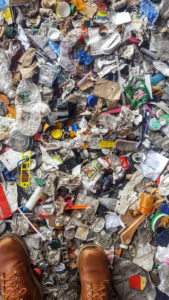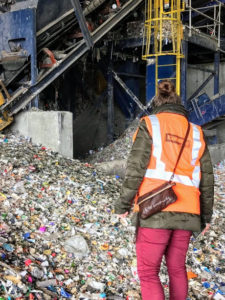This post was written by Sarah Healey ’18
What happened to that plastic bottle you threw in the recycling? Do you really have to rinse out that milk jug before putting it into the recycling? A little left-over yogurt doesn’t make a difference? Can you recycle plastic bags?
 If you are like a lot of people you probably don’t, and you hope or wish that the items you put in the bin get recycled. But this “wishcycling” can actually do more harm than just throwing contaminated or non-recyclable items away. On a recent site visit to Casella Waste Systems‘ Charlestown recycling facility in Massachusetts, I learned a lot about what happens to products after they go into the blue bin.
If you are like a lot of people you probably don’t, and you hope or wish that the items you put in the bin get recycled. But this “wishcycling” can actually do more harm than just throwing contaminated or non-recyclable items away. On a recent site visit to Casella Waste Systems‘ Charlestown recycling facility in Massachusetts, I learned a lot about what happens to products after they go into the blue bin.
At the recycling facility we visited, contamination was visible throughout our entire tour. Film plastic bags clogged the machines, small items fell through the cracks, and foreign metal objects damaged equipment. All of these items are not allowed in the zero sort recycling bins, but still manage to find their way in and wreak havoc.
During our tour of the recycling facility we learned more about the challenges that recycling facilities face. One of the major challenges is food contamination in the recycling stream. This can range from unwashed containers to cans still full of food. This has a massive impact on a recycling facility because items are sorted using all sorts of gadgets. To sort plastics the facility uses optic readers that read the type of plastic and send out puff of air to sort plastic. Other parts of the facility use things like magnets to sort material. Because so much of this system is automated and is carefully calibrated to deal with clean materials contaminated items don’t make it through the system.
 When non-recyclable items don’t make it through the system they are sent to the landfill or to an incinerator. This includes all of those small plastics, random pieces of metal, plastic bags, and more. This is why it is really important to check with your local recycler to see what products they take in the blue bin and which have special instructions.
When non-recyclable items don’t make it through the system they are sent to the landfill or to an incinerator. This includes all of those small plastics, random pieces of metal, plastic bags, and more. This is why it is really important to check with your local recycler to see what products they take in the blue bin and which have special instructions.
The trouble with recycling doesn’t stop at the facility though. The bundles produced by recycling facilities still have some level of contamination. The largest buyer of recycling was China, but they have closed their doors to recycling with contamination levels above 0.5%, which is beyond the technological capability of any recycling facility today.
